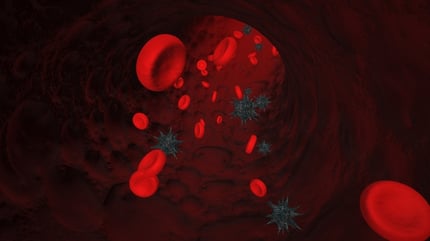
Maintaining a healthy blood sugar level can be complex and unyielding. In addition to food and beverages, our blood sugar levels fluctuate in response to a variety of other factors. Exercise, emotional stress, the previous night’s rest, and genetics all play a role in the body’s attempt to tightly regulate the levels of glucose circulating in the blood. Also, regardless of whether or not someone has a blood sugar dysregulation issue or full-blown diabetes, that morning meal we call breakfast sets the stage for the day.
What’s often termed the “Dawn Phenomenon” occurs between 4:00 AM – 8:00 AM when the body produces sufficient amounts of glucagon, cortisol, and epinephrine to raise blood glucose in preparation for waking. And science has got the backs of those preaching a hearty breakfast in the morning. One study that monitored the glucose profiles of healthy people throughout the day found the largest increase in blood glucose occurs right after breakfast. Just about every nutritionist, dietitian, and endocrinologist around recommend a high-protein breakfast to control the naturally-occurring spike in sugar in the morning. As mentioned, the subsequent foods, interactions, stressors, and other factors will dictate the variation in blood sugar level throughout the day, which directly impacts how the body functions and a person’s overall sense of well-being.
When Glucose Management is Challenged?
A consistently high blood glucose level has a deleterious effect on organ function. Risks for atherosclerosis, other heart diseases, stroke, kidney disorders, vision impairment, and circulatory issues that could lead to infections and amputation of extremities increase when the blood sugar level is uncontrolled. Extreme oscillations in blood sugar may stem from various hormonal imbalances, specifically where there is a lack of insulin production (i.e. Type I diabetes), or an inability to use insulin properly (i.e. insulin resistance). Either form of diabetes is identified and monitored with numerous tests, but most commonly the HbA1C.
As a marker of the longer-term blood sugar level, the HbA1C indicates the average percentage of the particular hemoglobin subtype A1C that has glucose bound to it (glycated or glycosylated) creating a glycoprotein. Since hemoglobin cells typically die off after 120 days, this assay safely represents the average plasma glucose level over about the previous 90 days. This diagnostic tool proves more helpful than a snapshot of blood sugar, which exhibits great vacillations throughout the day.
People with diabetes or longer periods of hyperglycemia, as found in patients diagnosed with metabolic syndrome, have elevated HbA1C levels. It’s estimated that in 2015 over 7 million cases of diabetes and insulin resistance went undiagnosed. The known prevalence of these conditions is alarming as the trend is nearing 10% of the population.
Stabilizing Blood Sugar with Nutrition
Although genetics is not something people can control, diet and other lifestyle factors are within the influence. Eating a balanced diet of low-glycemic, high fiber, and low-saturated-fat foods are recommended for individuals with glycemic control difficulties. Combining foods that contain all three macronutrients (protein, fat, and carbohydrates) is also helpful in managing blood sugar.
The following list of foods provides a good start to a healthy diet and a platform for avoiding those wild swings in sugar throughout the day:
- All colors of fresh fruits and vegetables
- Legumes, such as kidney beans, black beans, chickpeas, and lentils
- Whole grains such as brown rice, quinoa, barley, and millet
- Olive oil
- Tomatoes
- Fermented, organic, and raw dairy
- Cold-water wild fish such as salmon, mackerel, and sardines
- Tempeh, tofu and natto
- Cage-free, organic eggs
- Green and black tea
Supplemental nutrients and botanicals to help support healthy blood sugar levels and provide a hypoglycemic effect are currently being studied and include:
- Magnesium
- Chromium (as chromium picolinate)
- Vanadium
- Alpha-lipoic acid
- Gymnema Sylvestre
- Fenugreek
- Bitter melon
- Cinnamon
- Berberine
Berberine acts on multiple fronts. It was found to significantly improve glucose levels (from an average of 9.5% down to 7.5%), as effective as metformin (from 9.15% down to 7.7%), in a study to determine its efficacy and safety in type 2 diabetes patients. It also had the effect of improving both total cholesterol and low-density lipoprotein cholesterol in those study participants.
Other Key Lifestyle Factors
- A systematic review and meta-analysis of the effects of exercise on Type 2 diabetes showed that exercising more than 150 minutes per week significantly reduced the HbA1c levels of study participants and reduced the daily time spent in a hyperglycemic state by over two hours.
- Stress Management. The term “stress hyperglycemia” refers to a rise in blood sugar levels after an acute illness, which puts diabetes patients at an increased risk for co-morbidities and mortality. Furthermore, stress has been shown to negatively influence health risks, particularly in weight management. Researchers have examined biometrics of patients with type 2 diabetes and found plasma glucose concentrations significantly increased after exposure to acute psychological stress.
- Sleep disorders, such as obstructive sleep apnea, commonly associated with obesity and metabolic syndrome, can hinder good quality sleep and have been considered a risk factor for diabetes. Although there is no clearly defined correlation between sleep and glucose management, there are multiple pathways involved and a cascade of hormonal functions that can result in metabolic derangements when disturbed.
To stay steady on what can be a roller coaster ride of blood sugars, a high priority must be given to a well-balanced diet, replete with proper nutrients and supplementation, and the close monitoring of lifestyle and genetic factors.


